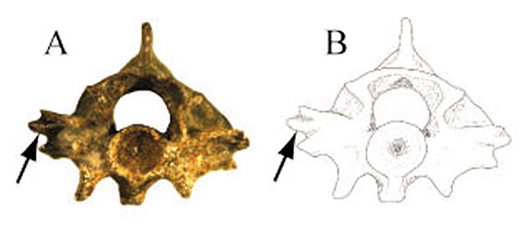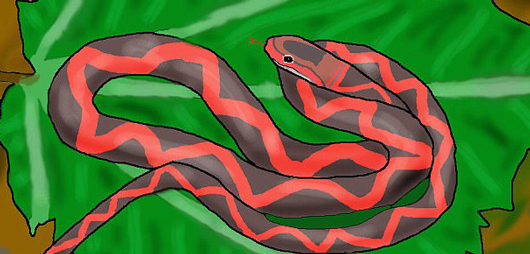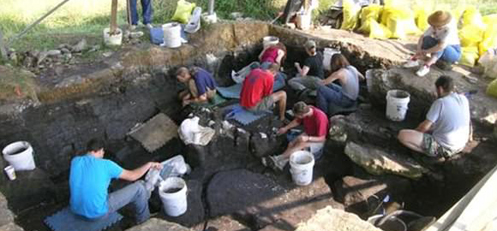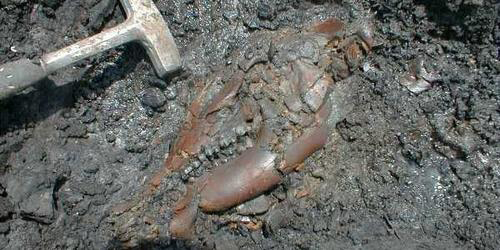Zilantophis schuberti – A New Species of Snake from the Gray Fossil Site
A newly described species of prehistoric snake is helping herpetologists to better understand the evolution of modern snakes. The new species, named Zilantophis schuberti is described in a scientific paper published this week in the “Journal of Herpetology”, it lived approximately five million years ago, a time when our planet’s global average temperature was rising. Scientists hope that this new discovery will provide helpful information so that they can better understand the ways in which today’s fauna will adapt with the onset of global warming.
An Illustration of the Newly Described Snake – Zilantophis schuberti
Picture credit: Steven Jasinski (University of Pennsylvania)
A Famous Fossil Site
Co-author of the paper, Steven Jasinski (PhD student at the University of Pennsylvania), explained that the fossils come from the famous Gray Fossil Site, close to East Tennessee State University, Jasinski and fellow author David Moscato (State Museum of Pennsylvania), report the discovery of highly modified, snake vertebrae, with wing-like struts, most probably to anchor strong back muscles. The morphology (shape) of these bones do not match any living species of snake, it has been speculated that these snakes developed specialised vertebrae to help them push through compacted leaf litter as they hunted for insects and other small prey. The specialised vertebrae may also have been an adaptation for digging or possibly swimming. The idea that Zilantophis was aquatic is difficult to rule out.
Photograph and Line Drawing of a Highly-Modified Vertebra

The arrow notes the location of wing-like projections that gave the species its name (Zilantophis schuberti).
Picture credit: Steven Jasinski (University of Pennsylvania)
PhD student Steven commented:
“Snakes don’t have arms or legs,* but they have high numbers of vertebrae. These are often the bones that palaeontologists use to identify fossil snakes.”
*Snakes and lizards belong to the Order Squamata, snakes evolved from limbed reptiles and recently Everything Dinosaur reported on the chance discovery of a 115-million-year-old fossil that provides evidence of the transition from reptiles with limbs to the serpentine form.
To read the article: First Fossil Snake with Four Limbs Described.
Named After a Mythical Creature
The genus name is derived from Zilant, a winged serpent from Tatar mythology. The trivial name honours Blaine Schubert, the executive director of East Tennessee State’s Don Sundquist Centre of Excellence in Palaeontology, who acted as mentor and adviser to the authors whilst they studied there. The ancient snake’s name translates as “Schubert’s winged snake”.
At only a few centimetres in length, Zilantophis was no monster, the tiny vertebrae had to be meticulously separated from the dark clay sediment of the Gray Fossil Site. The researchers conclude that this Late Miocene/Early Pliocene snake is most closely related to rat snakes (Pantherophis) and kingsnakes (Lampropeltis), both of which are relatively common in North America today. In total, the field team found evidence of seven different snake genera at the dig site, the descendants of which can still be found in east Tennessee today.
Field Team Members Working at the Sinkhole Dig Site
Picture credit: Steven Jasinski (University of Pennsylvania)
Snake genera identified include:
- Garter snakes (Thamnophis)
- Rat snakes (Pantherophis)
- Pine snakes (Pituophis)
- Whip snakes (Masticophis)
- Water snakes (Nerodia)
Zilantophis schuberti and all the snakes listed above, are members of the Colubridae snake family, the largest and most specious group of extant snakes. The authors comment that the Late Miocene was seeing a transition in snake fauna. Boas had dominated the serpentine fauna of North America, but gradually the boas went into decline and they were replaced by the colubrids, which are typically much smaller and more mobile than boas. This faunal change coincided with extensive climate change, with forests being replaced by open prairies as a result of a drying climate.
Steven Jasinski explained:
“Zilantophis was part of this period of change. It shows that colubrids were diversifying at this time, including forms that did not make it to the present day.”
The Importance of the Gray Fossil Site
The Gray Fossil Site, located close to the town of Gray in Washington County (Tennessee), represents deposits from a sinkhole that accumulated in the Late Miocene to the very Early Pliocene Epochs. As the clay deposits straddle the Miocene/Pliocene boundary, the strata and the fossils contained therein have provided researchers with an opportunity to study changing biodiversity at a time when the Earth’s climate was undergoing rapid change. Discovered seventeen years ago, during the construction of a road, the site represents the accumulated debris from the bottom of a large pond, that occasionally dried out. A wide variety of vertebrate fossils have been excavated from the site, including several large mammals, transitional forms of the American alligator, turtles, snakes and amphibians.
Excavating the Skull of a Tapir from the Dig Site
Picture credit: University of Pennsylvania
The Gray Fossil Site, has yet to be fully explored but it has already provided a hugely important window into the changing environment of North America between 7 million years ago and 4.5 million years ago (approximately). This new research represents the first formal survey of snake fossils at the location, the discovery of Zilantophis, which dates from the Hemphillian stage of the North American Land Mammal Ages (NALMA), is helping scientists to understand evolutionary change at a crucial time in the history of the fauna of North America, a time when modern animals and plants were becoming established.









Leave A Comment